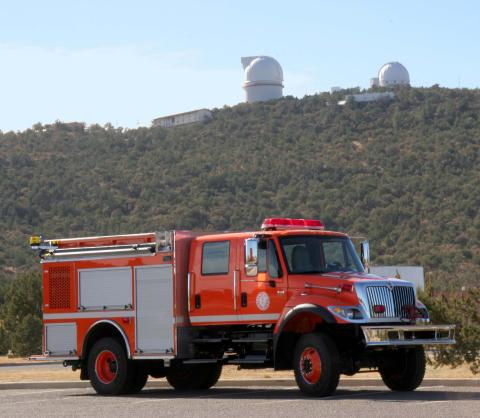Back in November 2004, Fire Marshal Garland Waldrop made protecting the McDonald Observatory a top priority when he joined forces with The Texas State Fire Marshal’s Office, Texas Forest Service, and Fort Davis Volunteer Fire Department to upgrade fire safety measures at The University of Texas at Austin’s world-class astronomy facility. Now, only two years later, what Waldrop calls a “precedent-setting collaboration of state agencies” has provided McDonald Observatory with new firebreaks, equipment, and personnel, earning it national recognition as a Firewise Community.

McDonald Observatory, a leading center for astronomical research and public education, is located in the Davis Mountains of West Texas, on the highest road in the state. Because the observatory is situated approximately 6,800 feet above sea level and is surrounded by acres of brush and trees, it is at high risk for wild land fires; for this reason, The Texas State Fire Marshal’s Office asked Waldrop to take part in an evaluation of the facility’s fire safety in 2004.
“It really is unusual to get that many state organizations working together for a common goal,” says Waldrop of the multi-agency effort to address McDonald’s fire safety deficiencies. “What was also unique is that the state fire marshal didn’t just do an inspection. They actually did an evaluation and a risk analysis in conjunction with the Texas Forest Service, and from those reports we identified a plan of action.”
“Some of the equipment that McDonald had was approaching obsolescence,” Waldrop notes. This is why he applied to the Texas Forest Service for a $108,000 grant, which university administration matched with $132,000 in order to purchase a new, custom designed orange fire truck.
In addition to the new fire truck, Waldrop and the Fire Prevention Services office worked to create another escape route down the mountain, open a new well for a secondary water source, and establish two firebreaks. (A firebreak is when you clear a plot of land by thinning brush and plant growth, thereby forming an area that slows the spread of fires and, sometimes, stops the fires.)
University administration — in conjunction with supporting the physical improvements to the observatory — also provided McDonald with two new personnel assignments whose full-time jobs will be to monitor fire safety. In early 2006, McDonald hired Steve Bramlett, a man with 27 years of firefighting experience, as their resident fire marshal, and they are in the process of hiring an assistant safety manager.
Bramlett, who has initiated a partnership with the Fort Davis Fire Department and is currently recruiting more volunteer firefighters, says, “Garland Waldrop’s team was instrumental in getting a lot of the administrative stuff handled, and I seriously doubt this could have been done without their help.”
“It’s been a team effort,” affirms Dr. Phil Kelton, McDonald’s superintendent, “but Garland’s one of the leaders, and he’s played a major role.”
Thanks to all these improvements, in July of 2005 McDonald Observatory was named a Firewise Community, becoming one of only 11 Texas communities to receive this distinction from the National Fire Service.
“It’s quite an honor,” Waldrop remarks, “because we’re being recognized by a national program that’s designed to encourage entire communities to become cognizant of fire safety and wild land fire safety.” He notes, however, that this honor is contingent on upholding McDonald’s commitment to fire safety and prevention efforts. The observatory plans to continue maintaining and creating new firebreaks in order to keep their Firewise Community status and — most important — to prevent fires.
“The goal for me has been protecting both the observatory and the community,” says Waldrop, adding that there are 30 residences on the observatory’s mountains that house 60 McDonald employees.
“The destruction of the observatory property would be in the hundreds of millions of dollars to replace, and some of it can’t be replaced because of the age of it,” he continues. “A lot of information, and scientific evidence and findings would be lost, so it really has been a plus for the university.”
Waldrop speaks of his personal attachment to the celestial views from the observatory: “It’s breathtaking every time you visit McDonald. I think everyone in Texas should make an effort to go there, especially families with small children — it really does give you a new lease on life each time you’re out there.”
“For me,” Waldrop concludes, “this is about the preservation of something that will be there for years for everyone in Texas.”
